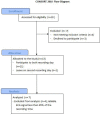Changes in Heart Rate Variability Recorded in Natural Situation with T-Shirt Integrated Sensors and Level of Observed Behavioral Excitation: A Pilot Study of Patients with Intellectual Disabilities and Psychiatric Disorders
- PMID: 28203208
- PMCID: PMC5285363
- DOI: 10.3389/fpsyt.2017.00004
Changes in Heart Rate Variability Recorded in Natural Situation with T-Shirt Integrated Sensors and Level of Observed Behavioral Excitation: A Pilot Study of Patients with Intellectual Disabilities and Psychiatric Disorders
Abstract
Background: The present study investigates the possibilities of using heart rate variability (HRV) parameters as physiological markers that precede increase in observed behavioral excitation of intellectually disabled individuals. The ability to recognize or predict such patterns, especially in patients showing unpredictable reactions and language deficiencies, might be a major step forward in clinical research.
Method: Thirteen volunteers with intellectual disabilities, who had suffered of at least one event of overt aggression in the preceding 3 months, participated to the study. The protocol consists in the acquisition of continuous electrocardiogram (ECG) throughout approximately two times of 8 h in natural situation, using a T-shirt integrated with sensors. Simultaneously, an observer evaluates the patient's level of overt excitation from calm (level 1) to extremely tense (level 5) and send online via Bluetooth these triggers into the ECG signals. The HRV indexes were then estimated offline on the basis of the inter-beat intervals recorded by the ECG, independently for the 30 min preceding each behavioral tension marking point, averaged, and compared through non-parametric Wilcoxon matched-pairs test. Of these, the RMSSD and LF/HF calculations were used to observe the fluctuations of inhibitory activity and cardiovagal balance through different tension states.
Results: Seven individuals have sufficient reliable data for analysis. They have reached at least a level 3 of behavioral excitation (moderately tense) or more (very to extremely tense, level 4 and 5) and have been retained for further analysis. In sum, a total of 197 periods of tension were kept, made up of 46 periods of slight excitation (level 2), 18 of moderate excitation (level 3), 10 of high excitation (level 4), and 5 of extreme agitation (level 5). Variations in the HRV as a function of degree of excitation are observed for RMSSD index only (inhibitory parasympathetic activity). The changes from calm to increasing levels of excitation are characterized by a significant downfall in RMSSD index when patients were evaluated to be in a very high level of tension (level 4).
Conclusion: The presence of precursors to agitation, reflected in the falling-off of parasympathetic activity, offers potentially interesting prospects for therapeutic development.
Keywords: heart rate variability; intellectual disability; parasympathetic nervous system; psychological stressors; sympathetic nervous system.
Figures



Similar articles
-
A new analysis of heart rate variability in the assessment of fetal parasympathetic activity: An experimental study in a fetal sheep model.PLoS One. 2017 Jul 10;12(7):e0180653. doi: 10.1371/journal.pone.0180653. eCollection 2017. PLoS One. 2017. PMID: 28700617 Free PMC article.
-
Assessing positive emotional states in dogs using heart rate and heart rate variability.Physiol Behav. 2016 Mar 1;155:102-11. doi: 10.1016/j.physbeh.2015.11.027. Epub 2015 Nov 26. Physiol Behav. 2016. PMID: 26631546
-
Comparison of heart rate variability parameters during complex partial seizures and psychogenic nonepileptic seizures.Epilepsia. 2012 Aug;53(8):1314-21. doi: 10.1111/j.1528-1167.2012.03518.x. Epub 2012 May 29. Epilepsia. 2012. PMID: 22642646
-
[Heart rate variability. Applications in psychiatry].Encephale. 2009 Oct;35(5):423-8. doi: 10.1016/j.encep.2008.06.016. Epub 2008 Dec 18. Encephale. 2009. PMID: 19853714 Review. French.
-
Mechanisms of morbidity and mortality from exposure to ambient air particles.Res Rep Health Eff Inst. 2000 Feb;(91):5-88; discussion 89-103. Res Rep Health Eff Inst. 2000. PMID: 10817681 Review.
Cited by
-
A Forest Bathing Intervention in Adults with Intellectual Disabilities: A Feasibility Study Protocol.Int J Environ Res Public Health. 2022 Oct 20;19(20):13589. doi: 10.3390/ijerph192013589. Int J Environ Res Public Health. 2022. PMID: 36294168 Free PMC article.
-
Reasons for disengagement in first-episode psychosis - perspectives from service users and their caregivers.BMC Psychiatry. 2024 Nov 11;24(1):788. doi: 10.1186/s12888-024-06190-4. BMC Psychiatry. 2024. PMID: 39529004 Free PMC article.
-
Dynamics of parasympathetic activity in violent incarcerated offenders before, during, and in recovery from an emotional inhibition task.Sci Rep. 2022 May 3;12(1):7126. doi: 10.1038/s41598-022-10872-y. Sci Rep. 2022. PMID: 35504982 Free PMC article.
-
The Utility of Physiological Measures in Assessing the Empathic Skills of Incarcerated Violent Offenders.Int J Offender Ther Comp Criminol. 2022 Jan;66(1):98-122. doi: 10.1177/0306624X21994056. Epub 2021 Feb 11. Int J Offender Ther Comp Criminol. 2022. PMID: 33567952 Free PMC article.
-
Development of a Wearable Biocueing App (Sense-IT) Among Forensic Psychiatric Outpatients With Aggressive Behavior: Design and Evaluation Study.JMIR Form Res. 2021 Nov 24;5(11):e29267. doi: 10.2196/29267. JMIR Form Res. 2021. PMID: 34821567 Free PMC article.
References
-
- Wechsler D. WAIS-R Manual: Wechsler Adult Intelligence Scale-Revised. San Antonio, TX: The Psychological Corporation; (1981).
-
- Wechsler D. Wechsler Adult Intelligence Scale–Fourth Edition (WAIS–IV). San Antonio, TX: NCS Pearson; (2008).
-
- American Psychiatric Association. Diagnostic and Statistical Manual of Mental Disorders DSM-IV-TR Fourth Edition (Text Revision). Washington, DC: American Psychiatric Association; (2000).
LinkOut - more resources
Full Text Sources
Other Literature Sources
Research Materials
Miscellaneous

